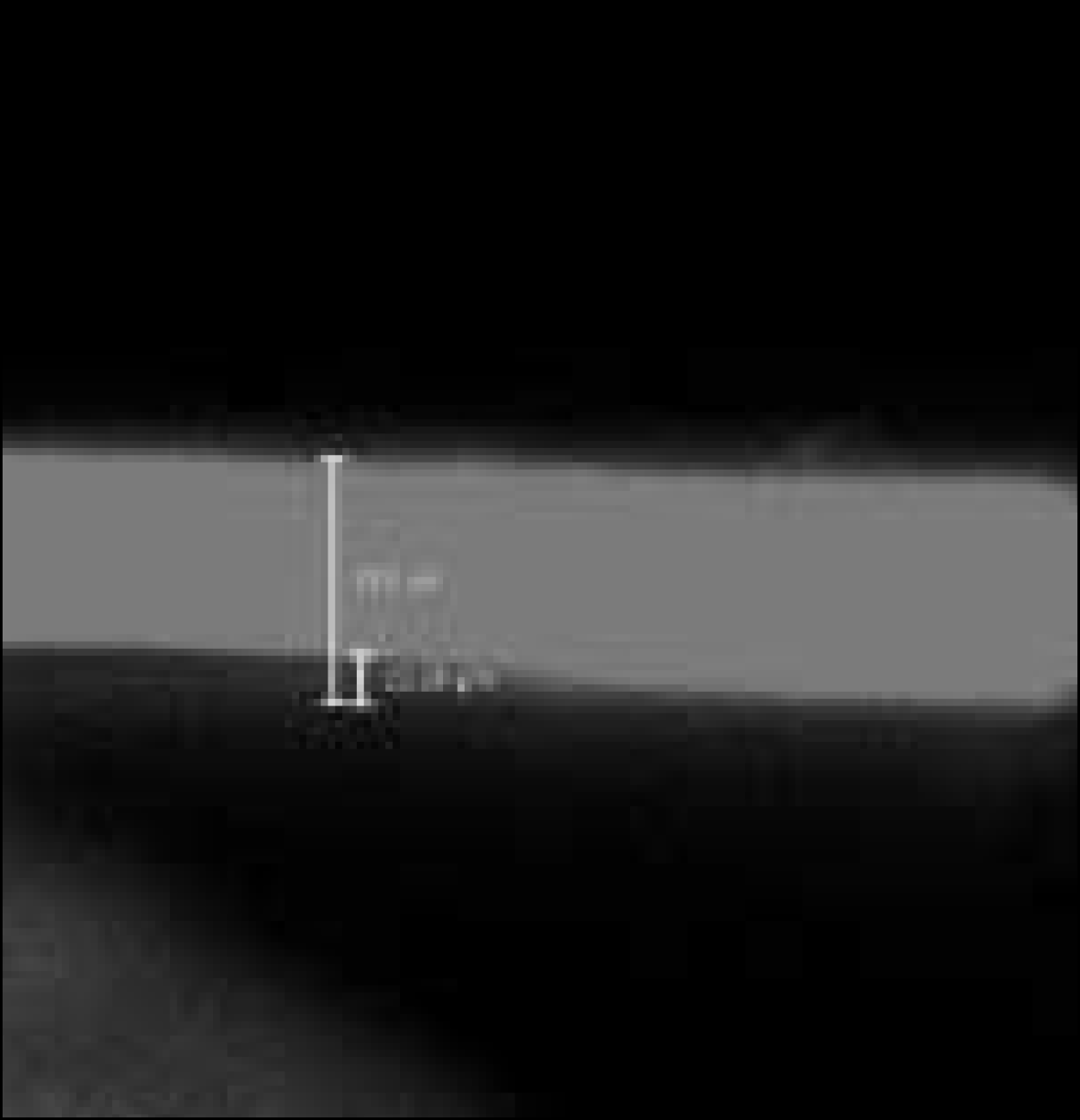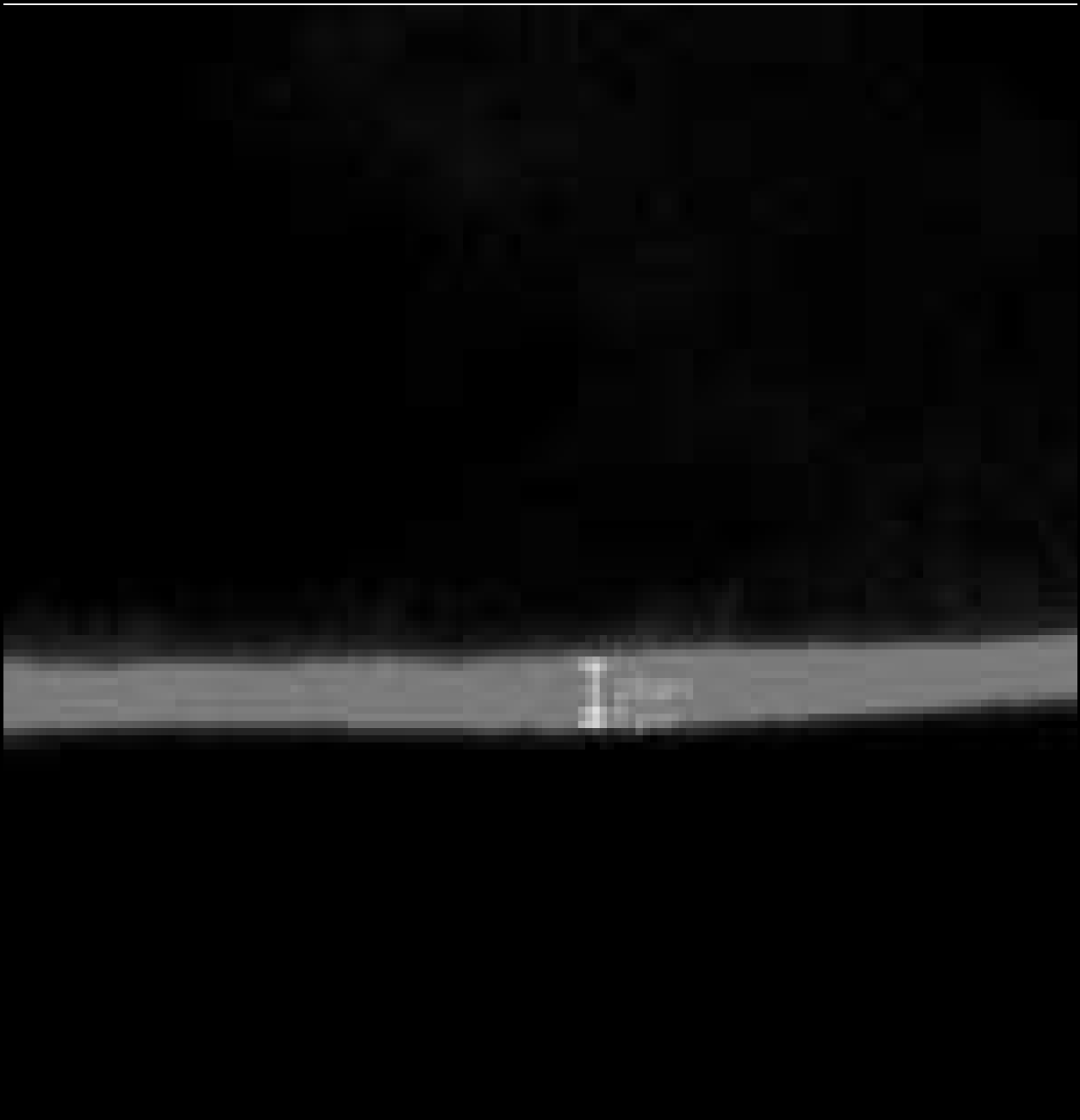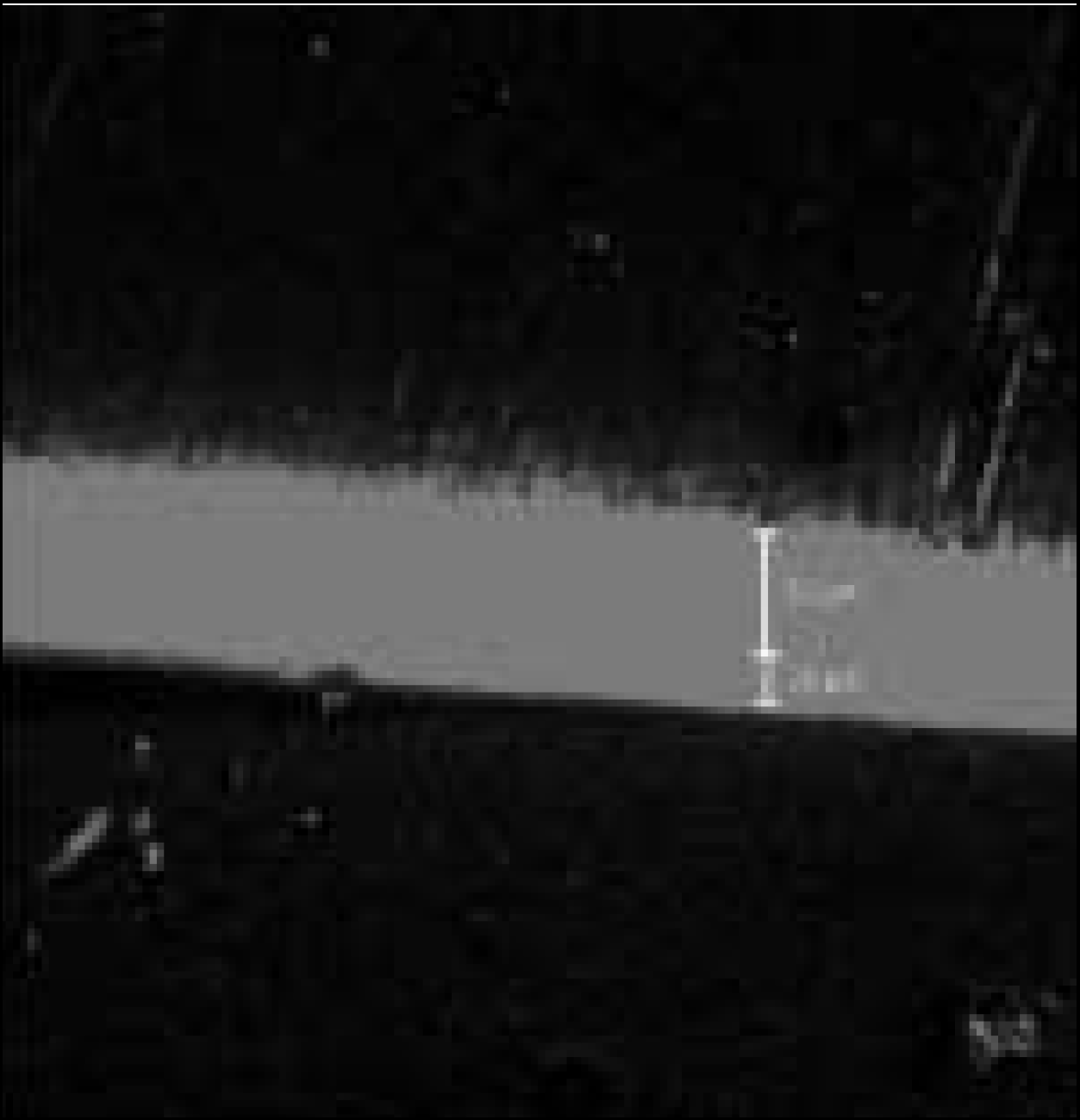ABSTRACT
The purpose of this study was to evaluate the effect of multiple application of all-in-one dentin adhesive system on microtensile bond strength using confocal laser scanning microscope and microtensile bond strength test. Flat occlusal dentin surfaces were prepared using low-speed diamond saw. In group I, Scotchbond Multipurpose (SM) was applied by manufacturer’s recommendation. In group II, after Adper Prompt L-Pop was applied for 15s and light cured for 10s, the second coat was re-applied and light-cured. In group III, after light-curing the second layer, the third coat was re-applied and light-cured. Specimens bonded with a resin-composite were sectioned into resin-dentin stick for measuring the adhesive layer thickness by confocal laser scanning microscope and evaluating micro-tensile bond strength. The adhesive layers of three-step dentin adhesive system, 3 coats of Adper Prompt L-Pop had significantly thicker than SM, 2 coats of Adper Prompt L-Pop (p < 0.05). However, there was no significant differences in bond strengths between SM and 3 coats of Adper Prompt L-Pop (p > 0.05). And SM, 3 coats of Adper Prompt L-Pop had significantly higher than 2 coats of Adper Prompt L-Pop in bond strengths (p < 0.05).
Go to : 
References
1. Bounocore M. A Simple method of increasing the adhesion of acrylic filling materials to enamel surfaces. J Dent Res. 34:849–853. 1955.

2. Frankenberger R, Kramer N, Petschelt A. Fatigue behaviour of different dentin adhesives. Clin Oral Investig. 3:11–17. 1999.

3. Tay FR, Gwinnett JA, Wei SH. Micromorphological spectrum of acid-conditioned dentin following the application of a water-based adhesive. Dent Mater. 14:329–338. 1998.

4. Walshaw PR, McComb D. Clinical considerations for optimal dentinal bonding. Quintessence Int. 27:619–625. 1996.
5. Nakabayashi N. Resin reinforced dentin due to infiltration of monomers into the dentin adhesive interface. J Jpn Dent Mat Devices. 1:78–81. 1982.
6. Perdigao J, Lopes M. Dentin bonding–questions for the new millennium. J Adhes Dent. 1:191–209. 1999.
7. Gwinnett AJ. Moist versus dry dentin: its effect on shear bond strength. Am J Dent. 5:127–129. 1992.
8. Kanca J. 3rd. Resin bonding to wet substrate. 1. Bonding to dentin. Quintessence Int. 23:39–41. 1992.
9. Kanca J. 3rd. Effect of resin primer solvents and surface wetness on resin composite bond strength to dentin. Am J Dent. 5:213–215. 1992.
10. Tanumiharja M, Burrow MF, Tyas MJ. Microtensile bond strengths of seven dentin adhesive systems. Dent Mater. 16:180–187. 2000.

11. Gwinnett AJ. Dentin bond strength after air drying and rewetting. Am J Dent. 7:144–148. 1994.
12. Pashley EL, Agee KA, Pashley DH, Tay FR. Effects of one versus two applications of an unfilled, all-in-one adhesive on dentine bonding. J Dent. 30:83–90. 2002.

13. Frankenberger R, Kramer N, Petschelt A. Technique sensitivity of dentin bonding:effect of application mistakes on bond strength and marginal adaptation. Oper Dent. 25:324–330. 2000.
14. Frankenberger R, Perdigao J, Rosa BT, Lopes M. “No-bottle”vs“multi-bottle”dentin adhesives–a microten-sile bond strength and morphological study. Dent Mater. 17:373–380. 2001.
15. Rosa BT, Perdigao J. Bond strengths of nonrinsing adhesives. Quintessence Int. 31:353–358. 2000.
16. Blunck U, Roulet JF. Marginal adaptation of com-pomer Class V restorations in vitro. J Adhes Dent. 1:143–151. 1999.
17. Frankenberger R, Kramer N, Oberschachtsiek H, Petschelt A. Dentin bond strength and marginal adaption after NaOCl pre-treatment. Oper Dent. 25:40–45. 2000.
18. Swift EJ Jr, Wilder AD Jr, May KN Jr, Waddell SL. Shear bond strengths of one-bottle dentin adhesives using multiple applications. Oper Dent. 22:194–1999. 1997.
19. Fritz UB, Finger WJ. Bonding efficiency of single-bottle enamel/dentin adhesives. Am J Dent. 12:277–282. 1999.
20. Bouillaguet S, Gysi P, Wataha JC, Ciucchi B, Cattani M, Godin C, Meyer JM. Bond strength of composite to dentin using conventional, one-step, and self-etching adhesive systems. J Dent. 29:55–61. 2001.

21. Platt JA, Almeida J, Gonzalez-Cabezas C, Rhodes B, Moore BK. The effect of double adhesive application on the shear bond strength to dentin of compomers using three one-bottle adhesive systems. Oper Dent. 26:313–317. 2001.
22. Choi KK, Condon JR, Ferracane JL. The effects of adhesive thickness on polymerization contraction stress of composite. J Dent Res. 79:812–817. 2000.

23. Krejci I, Kuster M, Lutz F. Influence of dentinal fluid and stress on marginal adaptation of resin composites. J Dent Res. 72:490–494. 1993.

24. Duke ES. Adhesion and its application with restorative materials. Dent Clin North Am. 37:329–340. 1993.
25. Feilzer AJ, De Gee AJ, Davidson CL. Setting stress in composite resin in relation to configuration of the restoration. J Dent Res. 66:1636–1639. 1987.

26. Braem M, Lambrechts P, Vanherle G, Davidson CL. Stiffness increase during the setting of dental composite resins. J Dent Res. 66:1713–1716. 1987.

27. Davidson CL, de Gee AJ, Feilzer A. The competition between the composite-dentin bond strength and the polymerization contraction stress. J Dent Res. 63:1396–1399. 1984.

28. Kemp-Scholte CM, Davidson CL. Complete marginal seal of Class V resin composite restorations effected by increased flexibility. J Dent Res. 69:1240–1243. 1990.

29. Zheng L, Pereira PN, Nakajima M, Sano H, Tagami J. Relationship between adhesive thickness and microten-sile bond strength. Oper Dent. 26(1):97–104. 2001.
30. Sudsangiam S, van Noort R. Do dentin bond strength tests serve a useful purpose? J Adhes Dent. 1:57–67. 1999.
31. Van Meerbeek B, Willems G, Celis JP, Roos JR, Braem M, Lambrechts P, Vanherle G. Assessment by nano-indentation of the hardness and elasticity of the resin-dentin bonding area. J Dent Res. 72:1434–1442. 1993.

32. Kemp-Scholte CM, Davidson CL. Marginal integrity related to bond strength and strain capacity of composite resin restorative systems. J Prosthet Dent. 64:658–664. 1990.

33. Hilton TJ, Schwartz RS. The effect of air thinning on dentin adhesive bond strength. Oper Dent. 20:133–137. 1995.
34. Ai H, Nagai M. Effect of the adhesive layer thickness on the fracture toughness of dental adhesive resins. Dent Mater J. 19:153–163. 2000.

35. Zheng L, Pereira PN, Nakajima M, Sano H, Tagami J. Relationship between adhesive thickness and microten-sile bond strength. Oper Dent. 26:97–104. 2001.
36. Frankenberger R, Kramer N, Petschelt A. Technique sensitivity of dentin bonding:effect of application mistakes on bond strength and marginal adaptation. Oper Dent. 25:324–330. 2000.
37. Walshaw PR, McComb D. Clinical considerations for optimal dentinal bonding. Quintessence Int. 27:619–625. 1996.
38. Oysaed H, Ruyter IE, Sjovik Kleven IJ. Release of formaldehyde from dental composites. J Dent Res. 67:1289–1294. 1988.

40. Ban S, Hasegawa J. Heat of polymerization of dimethacrylate monomers investigated by isothermal DSC measurement. Dent Mater. 3:85–92. 1984.

41. Rueggeberg FA, Margeson DH. The effect of oxygen inhibition on an unfilled/filled composite system. J Dent Res. 69:1652–658. 1990.

42. Perdigao J, Lambrechts P, Van Meerbeek B, Braem M, Yildiz E, Yucel T, Vanherle G. The interaction of adhesive systems with human dentin. Am J Dent. 9:167–173. 1996.
Go to : 
 | Figure 1.Confocal micrograph of specimen prepared with Scotchbond Multi-Purpose. The adhesive layer appeared by red color, is continuous across the interface. |
 | Figure 2.Confocal micrograph of specimen prepared with two application of Adper Prompt L-Pop. The adhesive layer is appeared by red color. |
 | Figure 3.Confocal micrograph of specimen prepared with three application of Adper Prompt L-Pop. It provides a more thick adheisve interface than 2coats of Adper Prompt L-Pop. |
Table 1.
Dentin bonding system used in this study
Table 2.
Adhesive system tested in the study and application protocol




 PDF
PDF ePub
ePub Citation
Citation Print
Print


 XML Download
XML Download